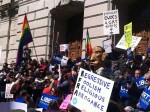If you want to know what political panic looks like, check out the fight for religious freedom. Let’s trace the steps:
1) Not long ago (2008, for instance), religious conservatives were taking a no compromise approach to same-sex marriage, declaring that theirs was a principled stance and that the future of the nation hung in the balance. There was no room for half-measures on this issue.
2) Majority opinion has shifted more rapidly than anyone predicted. Remember that in 2008 then-candidate Barack Obama – seeking the nomination of the more liberal party – wasn’t ready to embrace same-sex marriage as a federal priority. In the longer term, remember that the federal RFRA was a mainstream compromise in 1993, while Indiana’s similar legislation created a firestorm last week.
3) In response to their new-found minority status, many religious conservatives have rediscovered the virtues of “tolerance” and begun crying about persecution. (For the record, they’ve still got these terms wrong: disagreement isn’t ‘intolerance’ and losing a political fight you started isn’t the same as being targeted for abuse.) The most positive response is also perhaps the most ironic: religious conservatives now extolling the virtues of compromise.
But having recognized the source and symptoms of this panic, what do we do now? Steamrolling religious conservatives won’t do. If absolutism was wrong before (when it meant denying homosexuals equal rights), it’s equally wrong now (if it means denying meaningful religious liberty). If anything, there should be a higher standard because pluralism is actually a modern liberal priority, one to which conservatives have more often given lip service on their way to embracing various Americanization schemes. But pluralism is meaningless if it only applies to the like-minded.
I don’t have answers to all of Ross Douthat’s excellent questions. At this point, the best I can do is suggest the power of process. That’s what really sets the recent Utah legislation apart from the Religious Freedom Restoration Act in Indiana. The recent legislation that came out of Utah was the result of a cooperative process in which each side compromised, rather than a unilateral defense of religious liberty. The conservatives in Utah enacted the change while they still had the kind of solid majority that would have allowed for easy passage of an Indiana-style law.
Perhaps most importantly, the Utah legislation came out of meetings between the leaders of the two groups who had the real conflict: the Mormon Church and the LGBT community. Note that neither of those groups is the state. Indiana’s legislation gave the impression that the state had chosen the side of religious conservatives. In contrast, the process in Utah allowed leaders of both groups to create a cooperative political climate in which elected officials from both parties could then craft positive legislation.
The Utah solution won’t work for everyone. It bypassed the central issue addressed by the Indiana legislation: whether individuals can deny service on religious grounds. And most states don’t have a single set of religious leaders that can speak for such a large part of the population in these kinds of negotiations. But the process worked. If we’re going to figure out where we go from here, it’s an example worth following.
Latest posts by Jason LaBau (see all)
- Take Down the Confederate Monuments - August 14, 2017
- The Democratic Split - August 10, 2015
- On Lincoln and Our Second Founding - July 6, 2015

